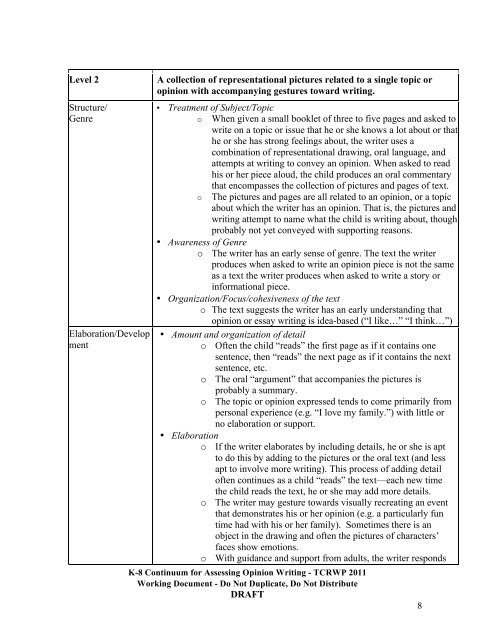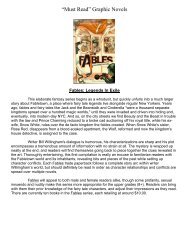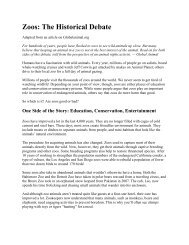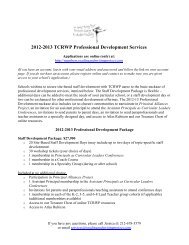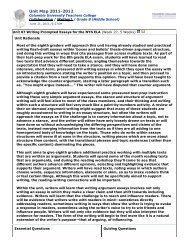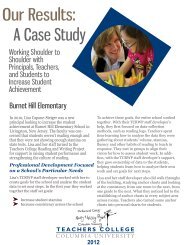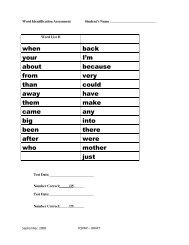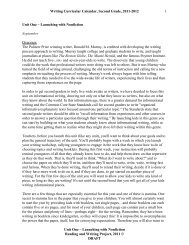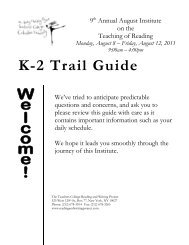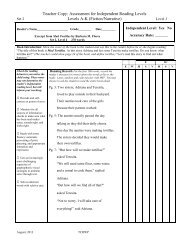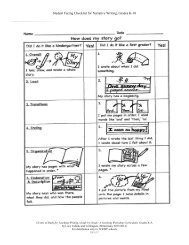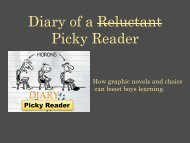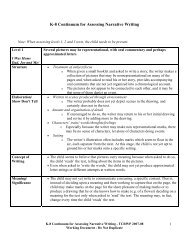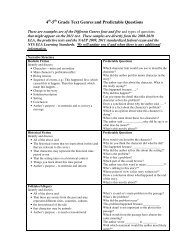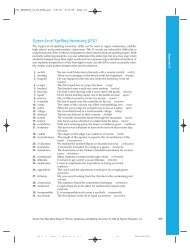Continuum for Assessing Opinion/Argument Writing - The Reading ...
Continuum for Assessing Opinion/Argument Writing - The Reading ...
Continuum for Assessing Opinion/Argument Writing - The Reading ...
You also want an ePaper? Increase the reach of your titles
YUMPU automatically turns print PDFs into web optimized ePapers that Google loves.
Level 2<br />
Structure/<br />
Genre<br />
Elaboration/Develop<br />
ment<br />
A collection of representational pictures related to a single topic or<br />
opinion with accompanying gestures toward writing.<br />
• Treatment of Subject/Topic<br />
o When given a small booklet of three to five pages and asked to<br />
write on a topic or issue that he or she knows a lot about or that<br />
he or she has strong feelings about, the writer uses a<br />
combination of representational drawing, oral language, and<br />
attempts at writing to convey an opinion. When asked to read<br />
his or her piece aloud, the child produces an oral commentary<br />
that encompasses the collection of pictures and pages of text.<br />
o<br />
<strong>The</strong> pictures and pages are all related to an opinion, or a topic<br />
about which the writer has an opinion. That is, the pictures and<br />
writing attempt to name what the child is writing about, though<br />
probably not yet conveyed with supporting reasons.<br />
• Awareness of Genre<br />
o <strong>The</strong> writer has an early sense of genre. <strong>The</strong> text the writer<br />
produces when asked to write an opinion piece is not the same<br />
as a text the writer produces when asked to write a story or<br />
in<strong>for</strong>mational piece.<br />
• Organization/Focus/cohesiveness of the text<br />
o <strong>The</strong> text suggests the writer has an early understanding that<br />
opinion or essay writing is idea-based (“I like…” “I think…”)<br />
• Amount and organization of detail<br />
o Often the child “reads” the first page as if it contains one<br />
sentence, then “reads” the next page as if it contains the next<br />
sentence, etc.<br />
o <strong>The</strong> oral “argument” that accompanies the pictures is<br />
probably a summary.<br />
o <strong>The</strong> topic or opinion expressed tends to come primarily from<br />
personal experience (e.g. “I love my family.”) with little or<br />
no elaboration or support.<br />
• Elaboration<br />
o If the writer elaborates by including details, he or she is apt<br />
to do this by adding to the pictures or the oral text (and less<br />
apt to involve more writing). This process of adding detail<br />
often continues as a child “reads” the text—each new time<br />
the child reads the text, he or she may add more details.<br />
o <strong>The</strong> writer may gesture towards visually recreating an event<br />
that demonstrates his or her opinion (e.g. a particularly fun<br />
time had with his or her family). Sometimes there is an<br />
object in the drawing and often the pictures of characters’<br />
faces show emotions.<br />
o With guidance and support from adults, the writer responds<br />
K-8 <strong>Continuum</strong> <strong>for</strong> <strong>Assessing</strong> <strong>Opinion</strong> <strong>Writing</strong> - TCRWP 2011<br />
Working Document - Do Not Duplicate, Do Not Distribute<br />
DRAFT<br />
8


